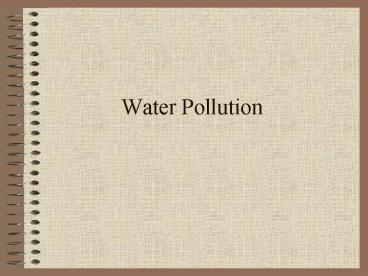Water Pollution - PowerPoint PPT Presentation
1 / 22
Title:
Water Pollution
Description:
Water pollutants classification. Thermal pollution. Soil erosion and sediment control ... Water Action Plan. Introduction. Types and sources of pollution ... – PowerPoint PPT presentation
Number of Views:1497
Avg rating:3.0/5.0
Title: Water Pollution
1
Water Pollution
2
Outline
- Water pollutants classification
- Thermal pollution
- Soil erosion and sediment control
- Stream pollution
- Lake pollution
- Ground water pollution
- Ocean Pollution
- Water Quality Standards
- Clean Water Action Plan
3
Introduction
- Types and sources of pollution
- Causes and consequences
4
Water Pollution by Source Types
- 1. Point sources of pollution Industrial
- 2. Non-Point / Diffuse source pollution
- watersheds, stormwater runoff, etc.
- River Flow Q1 m3/s Pollutant Conc. X
C1mg/LWastewater Flow Q2 m3/s Pollutant Conc.
X C2mg/L - Mixed Flow, Q3 m3/s and concentration of X,
C3mg/L at the mixing zone Flow at the mixing
zone Q3 m3/s Q1 Q2 - Applying principle of mass balanceconcentration
of X at the mixing zone C3 Q1 C1 Q2
C2/Q1 Q2
5
Classification of Water Pollutants
- Pathogens
- O2 demanding substances
- Plant nutrients
- Toxic Substances
- Inorganic chemicals
- Sediment
- Radioactive substances
- Heat
- Oil
6
Thermal Pollution
- Thermal pollution
- Cooling pond
7
Soil Erosion and Sediment Control
- Erosion Process
- Stream load
- Sediment and Soil Erosion Control
- Grass cover
- Mulching
- Diversion Channel
- Hay bates
- Fences
- Sediment basins
8
Stream Pollution
- Stream Pollution
- Dilution
- Dissolved O2 profile
- Zones of Pollution
- Computation of DO
9
(No Transcript)
10
(No Transcript)
11
(No Transcript)
12
Oxygen Sag Curve k1 Lo
-k1t -k2t
-k2t D ----------- 10 -
10 Do e k2 -
k1 whereD dissolved oxygen deficit at time
t, mg/L Do initial dissolved oxygen deficit
at time t0, mg/L k1 deoxygenation rate
constant, d-1 k2 reaeration rate
constant, d-1 Lo initial ultimate BOD at
time t0, mg/L t time of travel of
wastewater in the stream from point of discharge,
d Lo can be obtained using the
equation -k1t BODt Lo 1 - 10
Do DO saturation value - DO at the
mixing zone (Use Tables for DO saturation
values at different temperatures) The time of
travel to the point of minimum dissolved oxygen
concentration (the point of critical deficit)
critical time tc 1 k2
k2 - k1 tc -----------
ln --- ( 1 - D0 --------- )
k2 - k1 k1
k1Lo
13
Lake Pollution
- Eutrophication
- Thermal Stratification
14
Lake Pollution
- Water renewal time volume/ outflow rate t
V/Q - Thermal stratification of lakes
- Epilimnion (top, influenced by wind, top 5 - 10
m) - Hypolimnion (bottom, undisturbed,
photosynthetically unproductive) - Metalimnion or thermocline ( between epilimnion
and hypolimnion, marked thermal change) - Lake ecosystem
- Limnetic zone
- Trophogenic zone
- Tropholytic zone
- Benthic zone
- Littoral zone
15
Lake Pollution
- Based on the fertility of the water, lakes are
classified intoOligotrophic lakes, Mesotrophic
lakes and Eutrophic lakes - Municipal wastewater has 5.8 kg of N per capita
per year, and 1.5 kg of P per capita per year - About 60 of P is from detergents
- Conventional wastewater treatment removes 90 of
BOD, but only 40 of N and 30 of P - Chemical precipitation, if incorporated in
wastewater treatment, can effect 90 P removal - P is the growth limiting nutrient.
16
Lake Pollution
Zooplankton
Algae
Small fish
Big fish
Normal nutrient level
Excess nutrients leading to eutrophication
Algal bloom
Zooplankton
Small fish
Big fish
Floating algae mats
Lush weeds
Depletion of DO
Turbidity
Color
Odor
17
Prevention and Control of Eutrophication
- Preventing eutrophication means reducing
nutrients, - Municipal wastewater
- Incorporating chemical precipitation in treatment
for P removal - Diversion to other lakes, Disposal on land,
Groundwater recharge, Agricultural land drainage,
Soil conservation practices, Timing of fertilizer
applications, Control of fertilizer amounts
applied - Temporary Control Measures
- Harvesting of aquatic weeds, Chemical control of
plant growths (CuSO4 for algae) - Flushing out the lake if possible, Forcing mixing
of water(and/or adding oxygen) through pumping
18
Ground Water Pollution
- Sources of Contamination
- Industrial Waste
- Subsurface sewage disposal
- Municipal landfills
- Mining and petroleum products
- Agriculture
- Urban Areas
- Salt intrusion
- Preventive measures
- Tackle at source
19
Ocean Pollution
- Sewage
- Sludge
- Oil
20
Water quality Standards
- Maximum Contaminant Level Goal
- Maximum Residual Disinfectant Level
- CL Fl Turbidity 4
- Coliform 5 Positive
- Total trihalomethanes 80 ppb
- Haloacetic acid 60 ppb
- EPA standards
- Voluntary
- Clean Water Act
http//www.cityofseattle.net/util/services/waterqu
ality/ annualreport/default.htm http//www.cityofc
hicago.org/WaterManagement/wqr.pdf
21
Clean Water Action Plan
- Watershed Management Approach
- TMDLs
22
Midterm
- Make a synopsis of Chapter1, 3, 4 and 5.
- This will be worth 20 , the other 20 will have
to be submitted when we cover remaining chapters - In your synopsis of chapters, focus mainly on the
processes, cause-effect relationship and identify
public issues and management concerns related to
your project that is relevant in the Chapter.
Also link science and scientific method wherever
appropriate. - Make a concise summary not to exceed 2 single
spaced typed pages/ chapter. You may want to have
little less in short chapters like introduction
and more on longer chapters. - Please start working on it so that you can submit
it before the spring break - If there is any problem or anyone needs special
arrangements, please let me know. We will work
out an arrangement.































